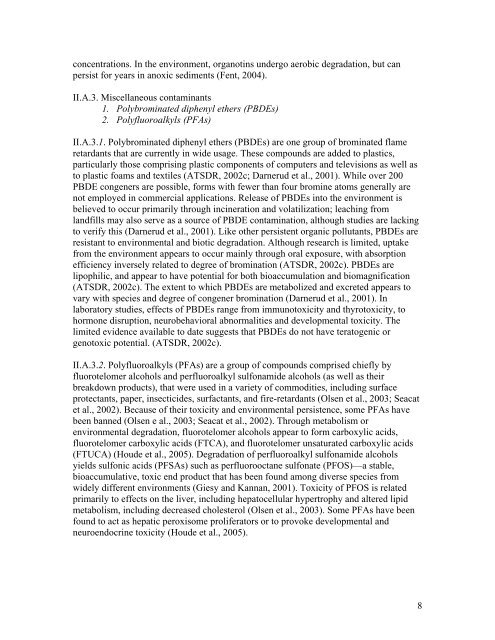Volume III, Appendices EM - National Marine Fisheries Service ...
Volume III, Appendices EM - National Marine Fisheries Service ...
Volume III, Appendices EM - National Marine Fisheries Service ...
You also want an ePaper? Increase the reach of your titles
YUMPU automatically turns print PDFs into web optimized ePapers that Google loves.
concentrations. In the environment, organotins undergo aerobic degradation, but can<br />
persist for years in anoxic sediments (Fent, 2004).<br />
II.A.3. Miscellaneous contaminants<br />
1. Polybrominated diphenyl ethers (PBDEs)<br />
2. Polyfluoroalkyls (PFAs)<br />
II.A.3.1. Polybrominated diphenyl ethers (PBDEs) are one group of brominated flame<br />
retardants that are currently in wide usage. These compounds are added to plastics,<br />
particularly those comprising plastic components of computers and televisions as well as<br />
to plastic foams and textiles (ATSDR, 2002c; Darnerud et al., 2001). While over 200<br />
PBDE congeners are possible, forms with fewer than four bromine atoms generally are<br />
not employed in commercial applications. Release of PBDEs into the environment is<br />
believed to occur primarily through incineration and volatilization; leaching from<br />
landfills may also serve as a source of PBDE contamination, although studies are lacking<br />
to verify this (Darnerud et al., 2001). Like other persistent organic pollutants, PBDEs are<br />
resistant to environmental and biotic degradation. Although research is limited, uptake<br />
from the environment appears to occur mainly through oral exposure, with absorption<br />
efficiency inversely related to degree of bromination (ATSDR, 2002c). PBDEs are<br />
lipophilic, and appear to have potential for both bioaccumulation and biomagnification<br />
(ATSDR, 2002c). The extent to which PBDEs are metabolized and excreted appears to<br />
vary with species and degree of congener bromination (Darnerud et al., 2001). In<br />
laboratory studies, effects of PBDEs range from immunotoxicity and thyrotoxicity, to<br />
hormone disruption, neurobehavioral abnormalities and developmental toxicity. The<br />
limited evidence available to date suggests that PBDEs do not have teratogenic or<br />
genotoxic potential. (ATSDR, 2002c).<br />
II.A.3.2. Polyfluoroalkyls (PFAs) are a group of compounds comprised chiefly by<br />
fluorotelomer alcohols and perfluoroalkyl sulfonamide alcohols (as well as their<br />
breakdown products), that were used in a variety of commodities, including surface<br />
protectants, paper, insecticides, surfactants, and fire-retardants (Olsen et al., 2003; Seacat<br />
et al., 2002). Because of their toxicity and environmental persistence, some PFAs have<br />
been banned (Olsen e al., 2003; Seacat et al., 2002). Through metabolism or<br />
environmental degradation, fluorotelomer alcohols appear to form carboxylic acids,<br />
fluorotelomer carboxylic acids (FTCA), and fluorotelomer unsaturated carboxylic acids<br />
(FTUCA) (Houde et al., 2005). Degradation of perfluoroalkyl sulfonamide alcohols<br />
yields sulfonic acids (PFSAs) such as perfluorooctane sulfonate (PFOS)—a stable,<br />
bioaccumulative, toxic end product that has been found among diverse species from<br />
widely different environments (Giesy and Kannan, 2001). Toxicity of PFOS is related<br />
primarily to effects on the liver, including hepatocellular hypertrophy and altered lipid<br />
metabolism, including decreased cholesterol (Olsen et al., 2003). Some PFAs have been<br />
found to act as hepatic peroxisome proliferators or to provoke developmental and<br />
neuroendocrine toxicity (Houde et al., 2005).<br />
8
















